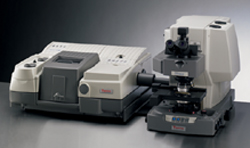Facilities
- AFM - Dimension Edge Scanning Probe Microscope
- SKP - Scanning Kelvin Probe
- VCM 600 STANDARD Vacuum Thermal Evaporator
- Theta Lite Optical Tensiometer
- Adhesion meter
- SECM Scanning electrochemical microscopy
- Potentiostat Bio-logic
- CompactStat potentiostat
- Potentiostat Autolab PGSTAT 12
- Potentiostat Autolab PGSTAT 30
- Radiometer Copenhagen CDM80 Conductivity Meter
- Ecocell 55 Drying oven
- Solartron 1286/1287 & Solartron 1250/1255 Electrochemical Impedance Analyzer
- Scanning Vibrating Electrode Technique
- SPS Spin 150 Spincoater
- Thermo Nicolet Nexus Fourier-Transform Infrared Spectrofotometer
AFM - Dimension Edge Scanning Probe Microscope
General Information
Instrument:
Atomic Force Microscope (AFM) Dimension Edge Scanning Probe Microscope Bruker
Location:
Materials Science and Engineering labs, ME
Key words:
AFM, tapping mode, contact mode, SKPFM
Main application:
Morphological investigations, surface potential mappings
Instrument specification
Performs topography measurements in air and liquid conditions on samples up to 150 mm in diameter / 15 mm thick and with lateral resolution of 10nm. Contact and tapping mode. Other properties such as Volta-potential measurements (SKPFM) are also available.
Amount of instruments installed:
One
Additional information:
Because of the sensitivity of the apparatus it can only be used under strict supervision after appointment when not used by members of the Corrosion Technology and Electrochemistry group.
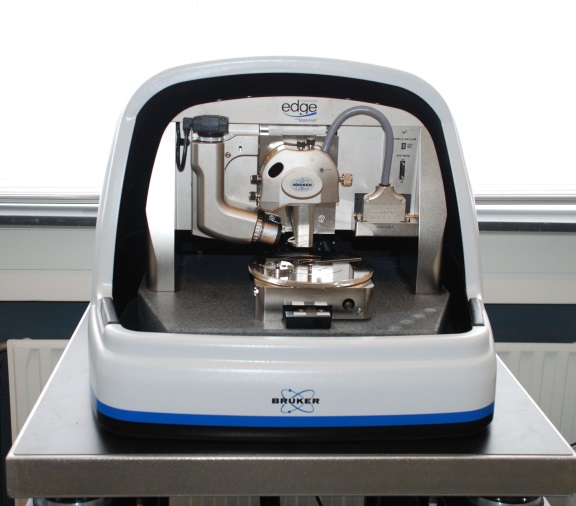
SKP - Scanning Kelvin Probe
General Information
Instrument:
Scanning Kelvin Probe, KP Technology
Location:
Materials Science and Engineering labs, ME
Key words:
SKP, Kelvin Probe
Main application:
Surface potential mappings, Coating delamination study
Instrument specification:
- corrosion/environmental housing with Automatic Relative Humidity Control to 1% (10-100% RH)
- 2mm and 50 micron tips standard
- Work Function resolution of 1-3meV
- 50mm x 50 mm maximum scan area
- 318 nanometer position resolution
- Tracking System with automatic motorised control of tip to sample spacing
- Additional Manual Height Control (25.4mm KP translation for coarse positioning)
- Off-null detection system with parasitic capacity rejection
Amount of instruments installed:
One
Additional information:
Because of the sensitivity of the apparatus it can only be used under strict supervision after appointment when not used by members of the Corrosion Technology and Electrochemistry group.
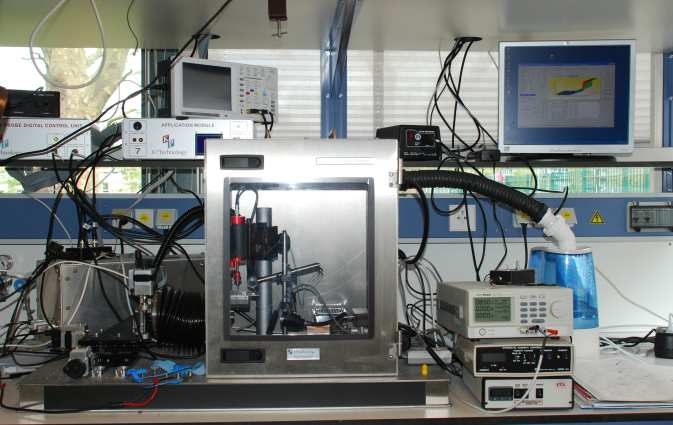
VCM 600 STANDARD Vacuum Thermal Evaporator
General Information
Instrument:
VCM 600 STANDARD Vacuum Thermal Evaporator, Norm Electronics
Location:
Materials Science and Engineering labs, ME
Key words:
Thermal Evaporation, Coatings, thin film, PVD
Main application:
Applying thin film metal coating
Instrument specification:
- Three thermal evaporation sources
- Quartz Crystal Thickness monitor unit
- TURBO pumping system
- Vacuum Measuring System (Pirani - Cold Plasma Penning)
- Maximum evaporation temperature - 1800 Celsius
Amount of instruments installed:
One
Additional information:
Because of the sensitivity of the apparatus it can only be used under strict supervision after appointment when not used by members of the Corrosion Technology and Electrochemistry group.
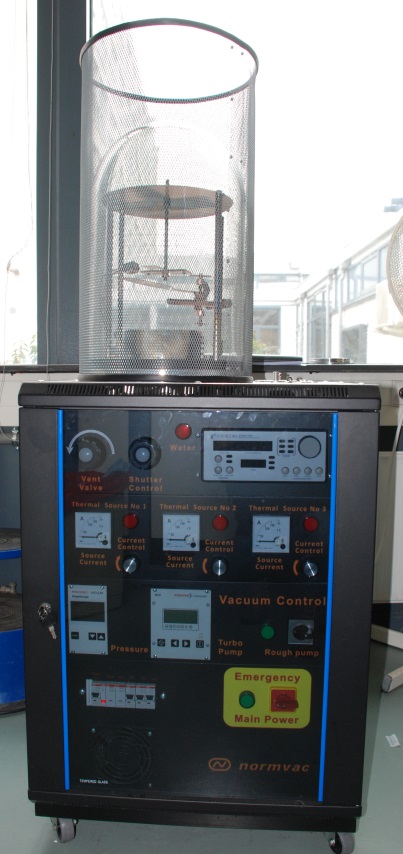
Theta Lite Optical Tensiometer
General Information
Instrument:
Theta Lite Optical Tensiometer
Location:
Materials Science and Engineering labs, ME
Key words:
Contact angle, surface free energy
Main application:
Measurement of static and dynamic contact angles, surface free energies, absorption and surface tension of liquids by pendant drop method.
Instrument specification:
- a digital video camera (USB2) based and fully computer controlled optical tensiometer
- Integrated sample stage. Movement range in z direction: 10mm
- Manual syringe dispenser with needle
- Full OneAttension Software for determination of:
- contact angle by sessile/raising drop method with automatic base line detection
- surface/interfacial tension by pendant/raising drop Method
- surface tension and contact angle by liquid meniscus Method
- Image fitting options: polynomial, Basforth-Adams, circular fit, Young-Laplace, including autobaseline algorithm
- Surface free energy
Amount of instruments installed:
One
Additional information:
Because of the sensitivity of the apparatus it can only be used under strict supervision after appointment when not used by members of the Corrosion Technology and Electrochemistry group.
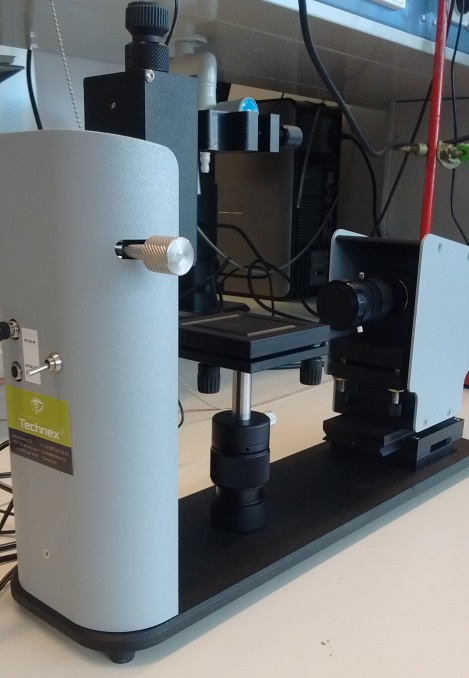
Adhesion meter
Instrument:
Elcometer 510 Automatic Pull-Off Adhesion Gauge
Location:
Materials Science and Engineering labs, ME
Key words:
Adhesion meter, pull-off method
Main application:
Measurement of the adhesion strength of coatings on a wide range of substrates.
Instrument specification:
- Automatic hydraulic pump ensures smooth and continuous pressure application for consistent, repeatable adhesion strength results
- Fully adjustable pull rates 0.1-1.4MPa/s (14.5-203psi) to meet National and International Standards
- Can be used with 10,14.2, 20 and 50mm diameter dollies
- USB and Bluetooth® data output - compatible with ElcoMaster® App for iPhone, iPod, iPad and Android mobile devices
Amount of instruments installed:
One
Additional information:
Because of the sensitivity of the apparatus it can only be used under strict supervision after appointment when not used by members of the Corrosion Technology and Electrochemistry group.

SECM Scanning electrochemical microscopy
Instrument:
Scanning Electrochemical Workstation Model 370, Princeton Applied Research, AMETEK
Location:
Materials Science and Engineering labs, ME
Key words:
SECM, scanning electrochemical microscopy
Main application:
local corrosion mechanisms study
Instrument specification:
The SECM integrates
- positioning system
Scan range (x, y, z) 70 x 70 x 70 mm
Scan motor resolution:8 nm - bipotentiostat
Current ranges:8 decades: 1 nA to 10 mA/V
Current resolution 61 fA
Maximum current ±20 mA - ultramicroelectrode tip
Amount of instruments installed:
One
Additional information:
Because of the sensitivity of the apparatus it can only be used under strict supervision after appointment when not used by members of the Corrosion Technology and Electrochemistry group.
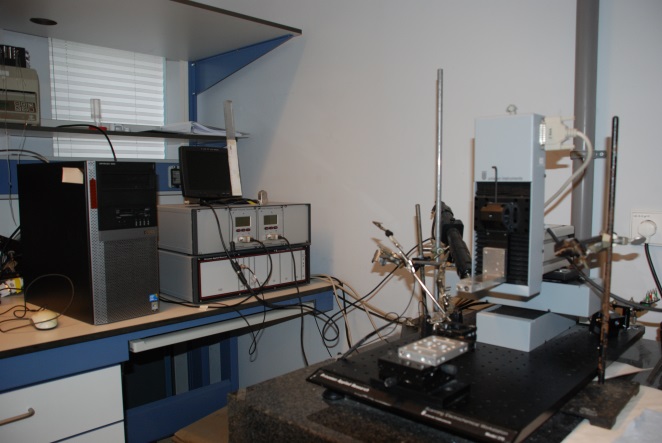
Potentiostat Bio-logic
Instrument:
Bio-Logic Potentiostat SP200
Location:
Materials Science and Engineering labs, ME
Key words:
electrochemistry, potentiostat, orp-eis
Main application:
dedicated for Odd Random Phase Impedance (ORP-EIS) measurements
Instrument specification:
- Compliance: ±12 V
- Control voltage: ±10 V
- EIS measurement: 3 MHz (1%, 1°) 7 MHz (3%, 3°)
- Current ranges: 500 mA to 1 µA (10 nA with gain)
- Current resolution 760 fA (standard board)
- Low current: 6 ranges from 100 nA to 1 pA with resolution to 76 aA
- Floating mode
- Analog filtering
- Calibration board
- Full stability control mode (9 bandwidths)
Amount of instruments installed:
One
Additional information:
Because of the sensitivity of the apparatus it can only be used under strict supervision after appointment when not used by members of the Corrosion Technology and Electrochemistry group.
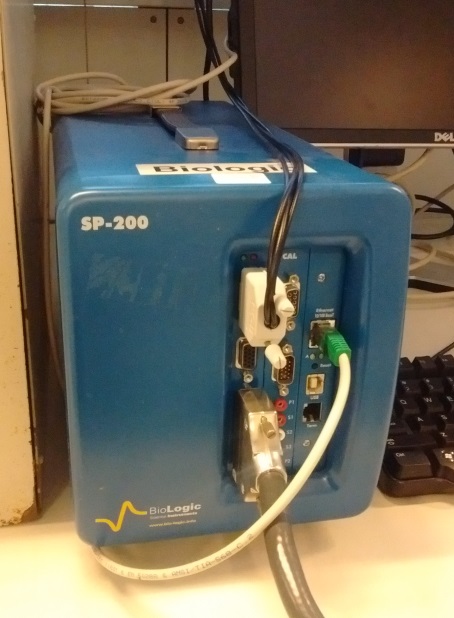
CompactStat potentiostat
Instrument:
CompactStat potentiostat, IVIUM Technologies
Location:
Materials Science and Engineering labs, ME
Key words:
Potentiostat, Electrochemial noise
Main application:
Portable Electrochemical Interface & Impedance Analyser, dedicated for Electrochemical Noise measurements.
Instrument specification:
- Power configuration: ±30mA @ ±10V
- FRA/EIS: 10µHz - 3MHz
- Mobile electrochemical measurement station for corrosion and analytical applications, can be operated via the USB port from a pc, without additional power supply
- Low noise (capable of determining very small signals, such as required in nano-technology applications)
- Galvanic isolation from power lines and PC
Amount of instruments installed:
One
Additional information:
Because of the sensitivity of the apparatus it can only be used under strict supervision after appointment when not used by members of the Corrosion Technology and Electrochemistry group.
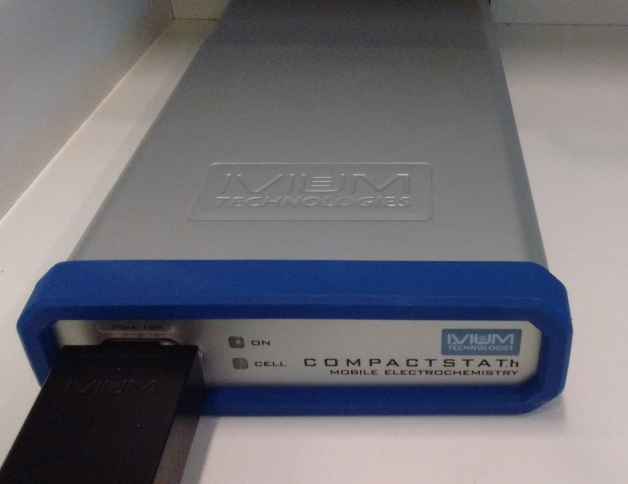
Potentiostat Autolab PGSTAT 12
General Information
Instrument:
Potentiostat Autolab PGSTAT 12
Location:
Material Science and Engineering lab, ME
Key words:
potentiostat, electrochemistry
Main application:
General-purpose potentiostat. Primarily used for educational and short-term experiments.
Instrument specifications:
Electrode connections: 2, 3 or 4
Potential range: ± 10 V
Compliance voltage: ± 12 V
Maximum current: ± 250 mA
Current ranges: 100 mA, 10 mA, 1 mA, 100 µA, 10 µA, 1 µA, 100 nA, 10 nA
Potentiostat bandwidth: 500 kHz
Computer interface: Proprietry via PC (ISA-16bit) interface
Electrochemical techniques
DC-techniques & AC voltammetry
Amount of instruments installed
Surfaces & Interfaces owns a total of four PGSTAT 12’s. One of these machines is currently located in the Vrije Universiteit Brussel (prof. Terryn).
Potentiostat Autolab PGSTAT 30
General Information
Instrument:
Potentiostat Autolab PGSTAT 30
Location:
Materials Science and Engineering lab, ME
Key words:
impedance, EIS, FRA, potentiostat, electrochemistry
Main application:
General purpose potentiostat & electrochemical impedance analyser (EIS).
Instrument specifications:
Electrode connections: 2, 3 or 4
Potential range: ± 10 V
Compliance voltage: ± 30 V
Maximum current: ± 2 A
Current ranges: 1A, 100 mA, 10 mA, 1 mA, 100 µA, 10 µA, 1 µA, 100 nA, 10 nA
Potentiostat bandwidth: 1 MHz
Computer interface: USB
Electrochemical techniques
DC-techniques, AC-voltammetry & Impedance Spectroscopy (EIS)
Amount of instruments installed
Surfaces & Interfaces owns a total of two PGSTAT 30s.
Additional information
Each one has an additional module that expands the possibilities: One PGSTAT 30 has a MUX4 module that allows sequential (computer controlled) operation of four electrochemical cells. The other PGSTAT 30 has a pX module that allows simultaneous logging of an additional signal from e.g. a pH electrode or different sensor.
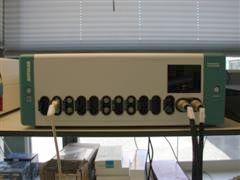
Radiometer Copenhagen CDM80 Conductivity Meter
General Information
Instrument:
Radiometer Copenhagen CDM80 Conductivity Meter
Description:
Conductivity meter for aqueous electrolytes
Location:
Materials Science and Engineering lab, ME
Key words:
electrochemistry, conductivity
Main application:
Determination of aqueous electrolyte conductivity
Instrument specification:
Conductivity range: 20 μS/cm - 200 mS/cm
Temperature range:
15 - 45° C
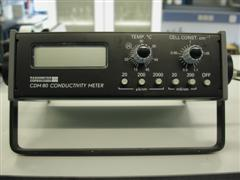
Ecocell 55 Drying oven
General Information
Instrument:
Ecocell 55 Drying oven
Location:
Materials Science and Engineering lab, ME
Key words:
drying, heating, oven, temperature contoller, heater
Main application:
Heating and cooling of materials.
Instrument specification
Drying oven MMM Medcenter
Type: Ecocell 55
Tmax: 250°
Width: 400 mm
Depth: 390 mm
Height: 350 mm
Two Ecocell ovens are present.
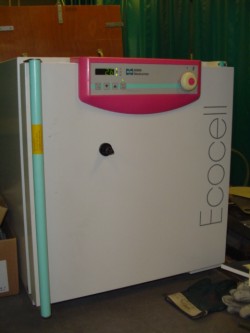
Solartron 1286/1287 & Solartron 1250/1255 Electrochemical Impedance Analyzer
General Information
Instrument:
Solartron 1286/1287 & Solartron 1250/1255 Electrochemical Impedance Analyser
Location:
Materials Science and Engineering lab, ME
Key words:
EIS, electrochemistry
Main application:
These setup are used to characterise electrochemical processes occurring at coated and non-coated metal surfaces.
References:
DH van der Weijde, EPM van Westing and JHW de Wit, Materials Science Forum 289-2: 237-245, Part 1&2, 1998
Instrument specification
Instrument specifications: Potentiostat
Electrode connections: 2, 3 or 4
Potential range: ± 12 V
Compliance voltage: ± 30 V
Maximum current: ± 2 A
Current ranges: 2A, 200 mA, 20 mA, 2 mA, 200 µA, 20 µA, 2 µA, 200 nA
Potentiostat bandwidth: 1 MHz
Input impedance: >10 GΩ
Computer interface: IEEE-488 (GP-IB)
Instrument specifications: Frequency Response Analyser
DC Bias range: ± 41V
max Bias current: ± 100mA
AC frequency range: 10μHz - 20 MHz (1MHz in aqueous electrolytes)
Electrochemical techniques
DC-techniques, AC-voltammetry & Impedance Spectroscopy (EIS)
Amount of instruments installed
Surfaces & Interfaces owns a total of three 1287s, four 1286s, four 1255s and two 1250s. Together, these allow six impedance setups to be built. In addition to these instruments, two Autolab PGSTAT 30s are available for EIS measurements as well.
Additional information
All EIS setups are galvanically isolated from their controlling PCs to maintain clean signals. This is performed by connecting the PC through National Instruments GPIB-120A bus isolators. Faraday cages are used to shield EM radiation from the experiment. Clean measurement earthing terminals are available throughout the lab.
All EIS setups are controlled using Scribner Associates Corrware & ZPlot software.
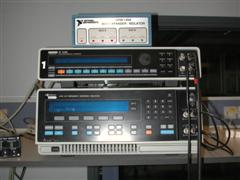
Scanning Vibrating Electrode Technique
General Information
Instrument:
Scanning Vibrating Electrode Technique
Location:
Materials Science and Engineering lab, ME
Key words:
Electrochemistry, current density map
Main application:
Map the current/potential density distribution occurring at a fixed distance above a metal surface freely corroding in solution
Instrument specification
Spatial resolution: 10-20μm
Camera magnificent: 1*0.75~ 7* 0.75
Scan heights: 50-250 μm (usually 100 μm)
Measuring area: about 120 μm *120 μm(with 7*0.75)
Working condition: in solution
Probe type: platinum, Stainless still, glass
Reference microelectrode: saturated Ag/AgCl
Electrochemical techniques
Combined with electrochemical analyzer
Amount of instruments installed
Surfaces & Interfaces owns a total of one SVET
Additional information
The SVET can be used to map the electrochemical behavior above a metal surface in aqueous electrolyte. This is useful to evaluate and spatially resolve corrosion activities. It has an excellent signal-to noise ratio, and increased electrical sensitivities as well as enhanced system stability.
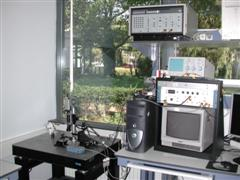
SPS Spin 150 Spincoater
General Information
Instrument:
SPS Spin 150 Spincoater
Location:
Materials Science and Engineering lab, ME
Key words:
Spin coating
Main application:
Application of coatings on substrates via spinning process
Instrument specification
Full-Plastic System in Polypropylene
Table-Top Model (Footprint: 39cm x 28cm)
Process Chamber Diameter: 200mm
Substrate size: fragments and substrates up to Ø150mm (6”)
Transparent Lid with Central Nitrogen Diffuser with Syringe Holder provision
2 Programmable Switch Contacts: Dispense On/Off, Nitrogen On/Off
Manual Chemical Dispense
Easy, step-by-step Programming via Gloved-Finger-Friendly Keyboard
with LED Backlit Display
Programmable Digital Process Controller,
Programmable Storage of 20 Programs with 99 steps / each for:
Time 1-999 sec/step, Speed 1-6.000 RPM +/- 1 RPM,
Acceleration/Dec. 1-3.000 RPM/Sec +/- 1 RPM/Sec., Vacuum On/Off
2 Programmable ON/OFF Switching Outputs
e.g. for Dispense On/Off, Nitrogen On/Off, etc.
Digitally controlled Motor with digital incremental speed signal feed back
CE-approved
Amount of instruments installed:
One
Additional information:
The apparatus can only be used after appointment when not used by members of the Corrosion Technology and Electrochemistry group.
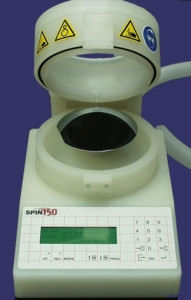
Thermo Nicolet Nexus Fourier-Transform Infrared Spectrofotometer
General Information
Instrument:
Thermo Nicolet Nexus Fourier-Transform Infrared Spectrofotometer
Location:
Materials Science and Engineering lab, ME
Key words:
FTIR, microscope, grazing angle, infrared, spectrometer, ATR
Main application:
The FTIR spectrofotometer is primarily used to study the bonding characteristics of (model) molecules on metal plate samples (Al, Mg, Au, steel).
References:
J van den Brand, O Blajiev, PCJ Beentjes, H Terryn, JHW de Wit. Langmuir 20(15) 6318-6326, 2004
Instrument specification
The Nexus module comes equipped with MCT-A and MCT-B detectors, which are both cooled with liquid nitrogen and have a range of 4000 – 600 cm-1 and 4000 – 400 cm-1. There are three sample holders present: transmission (through coatings), Golden Gate (reversed ATR) and a Specac grazing angle module with polarizer, which can handle angles up to 85° to study low concentration surface interactions.
The Continuµm Infrared Microscope comes equipped with a MCT-A detector, cooled with liquid nitrogen. A 10x magnification objective can be used to make reflective surface scans with a resolution of about 10µm. Alternatively, this objective can be replaced with an ATR crystal module.
Amount of instruments installed:
One, owned by Netherlands Institute for Metals Research (NIMR)
Additional information:
Because of the sensitivity of the apparatus it can only be used under strict supervision after appointment when not used by members of the S&I group.
